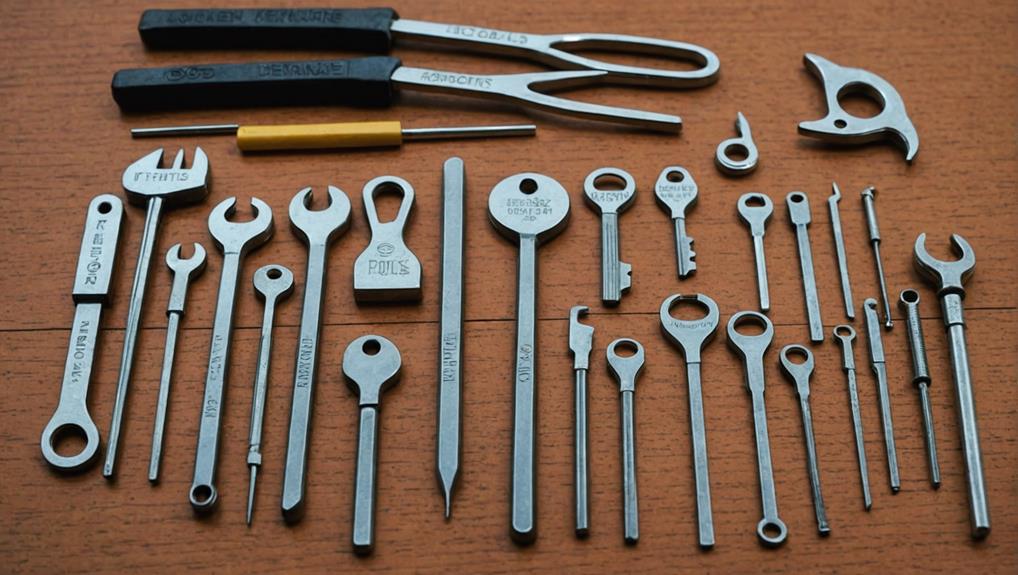Reveal the intricate world of lock picking with techniques like the Pin Tumbler method for aligning pins, or the Raking Technique for quick access. Precision in Single-Pin Picking enables success through patience and a delicate touch. Bypass Tools provide non-destructive entry options, enhancing security navigation. Tubular Lock Picking demands specialized tools for accurate manipulation. Ethical practices like Impressioning and Decoding reveal lock vulnerabilities. Advanced Electronic Lock Picking requires knowledge of electronic components. Skill improvement through practice on various locks is key. Enhance your security arsenal with mastery of these techniques and tools.
Key Takeaways
- Pin tumbler and single-pin picking techniques are essential skills.
- Raking allows quick entry without individual pin manipulation.
- Bypass methods like impressioning and decoding aid in non-destructive entry.
- Tool selection based on lock type and quality impacts effectiveness.
- Practice, feedback, and goal setting improve lock picking proficiency.
Basic Pin Tumbler Lock Picking
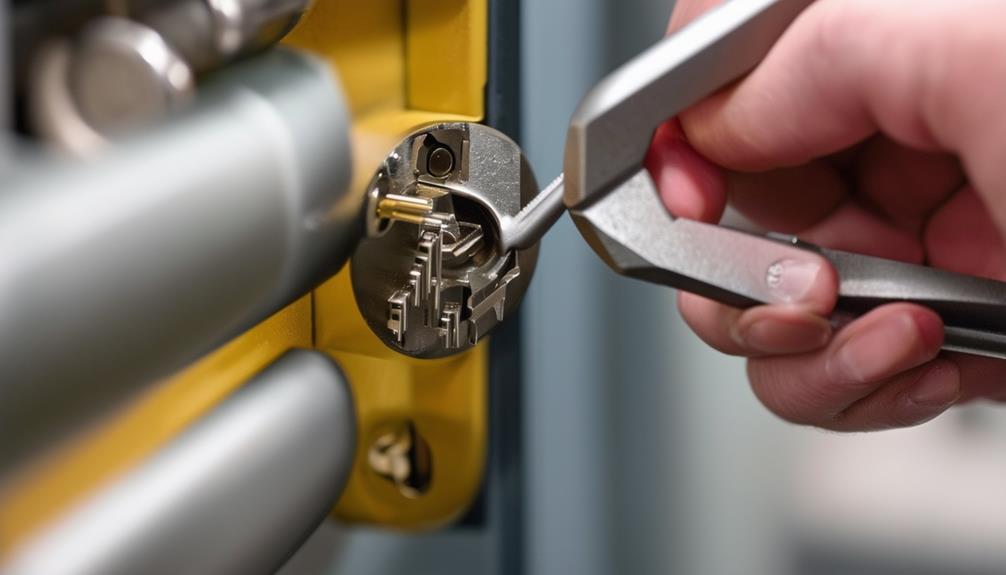
When it comes to basic pin tumbler lock picking, understanding the inner workings of the mechanism is essential.
Pin tumbler locks, which are prevalent in residential and high-security applications, have a series of spring-loaded pins that must be precisely aligned to open the lock.
To pick a pin tumbler lock, you'll need a tension wrench and a lock pick. The tension wrench is used to apply slight pressure to the lock, mimicking the action of a key turning.
Insert the tension wrench into the bottom of the keyway and apply gentle pressure in the direction you'd turn a key.
Next, insert the lock pick above the tension wrench and push up on each pin which helps in aligning the tumblers. As you push up on the pins, you'll feel them set into place.
Once all pins are set, continue applying pressure with the tension wrench and turn it in the direction of the key.
With practice, mastering these basic lock picking techniques will become second nature.
Raking Technique for Quick Entry
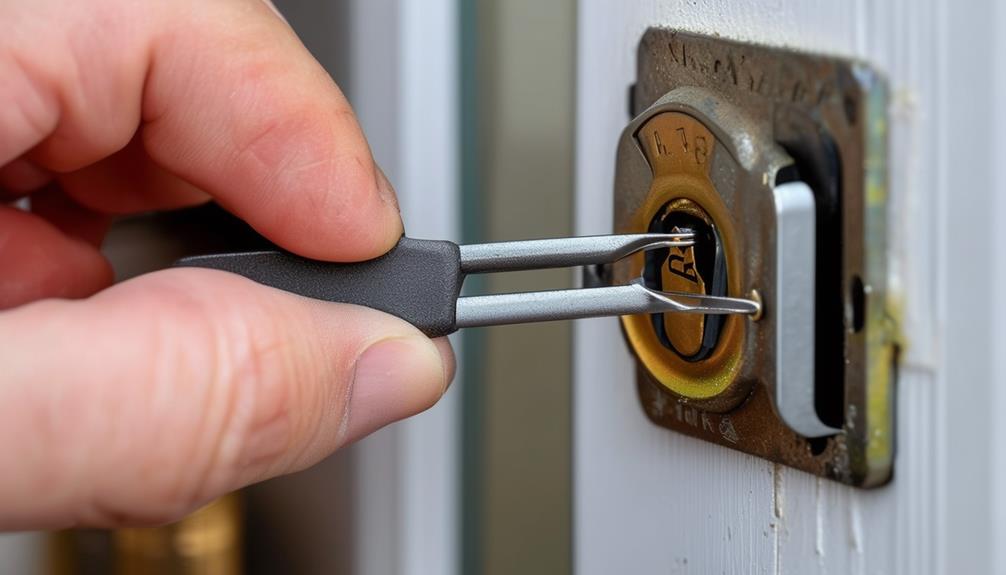
When you need to gain quick access through a lock, the raking technique can be your go-to method. This technique is favored by many lock picking competitors for its efficiency and speed, as it allows practitioners to bypass locks without engaging in the more time-consuming process of picking each pin individually.
Raking involves swiftly manipulating the lock pins to simulate the action of a key, allowing for fast entry without individual pin picking. To effectively rake a lock, having the right tools and mastering the proper techniques are essential for security professionals looking to quickly bypass locks.
For more insights on effective strategies, check out proven techniques that can help you win lock picking competitions.
Fast Entry With Raking
Looking to gain quick entry in a non-destructive manner? The raking technique can be your go-to method for fast entry when picking locks. Raking involves using a rake tool to rapidly move the pins inside the lock, trying to set them all at once. This method is known for its speed and efficiency, making it a popular choice for security professionals needing to gain access quickly.
To rake a lock effectively, insert the rake tool all the way into the keyway and apply slight pressure on the tension wrench. Then, rapidly move the rake tool up and down while simultaneously applying pressure. The goal is to mimic the action of a key moving in and out of the lock, manipulating the pins until they set into place, allowing the lock to turn.
While raking isn't as precise as single pin picking, it can be highly effective in certain situations where speed is essential.
Practice this technique to improve your lock picking skills and gain faster access when needed.
Rake for Lockpicking
Utilizing the raking technique for lockpicking provides security professionals with a swift and efficient method of gaining access to locks without causing damage.
A rake for lockpicking is a tool that resembles a small rake with multiple ridges or bumps. When inserted into a lock, the rake is moved back and forth in a rapid motion while varying the pressure applied. This technique aims to manipulate the lock pins simultaneously, causing them to set into the correct position and allowing the lock to turn.
Rakes are particularly useful for quickly opening simple pin tumbler locks, making them a popular choice for professionals who need to gain entry rapidly.
While raking is effective for basic locks, it may not work on more complex or high-security locks that require specific pin manipulation.
Security professionals can enhance their raking skills by practicing on different types of locks and experimenting with various rake designs.
Understanding the rake for lockpicking and mastering this technique can greatly improve a professional's efficiency in gaining entry when needed.
Raking Tools and Tips
To efficiently utilize the raking technique for quick entry, security professionals rely on specific raking tools and tips.
When it comes to raking tools and tips, there are certain key considerations to keep in mind:
- Choose the Right Rake: Select a rake that fits the keyway of the lock you're working on. Different locks may require different rake designs for ideal results.
- Apply Proper Pressure: Use just the right amount of tension when raking the lock. Applying too much or too little pressure can hinder the effectiveness of the technique.
- Practice Different Techniques: Experiment with various raking techniques to find what works best for you. Each lock may respond differently to raking, so being versatile in your approach is key to success.
Single-Pin Picking for Precision
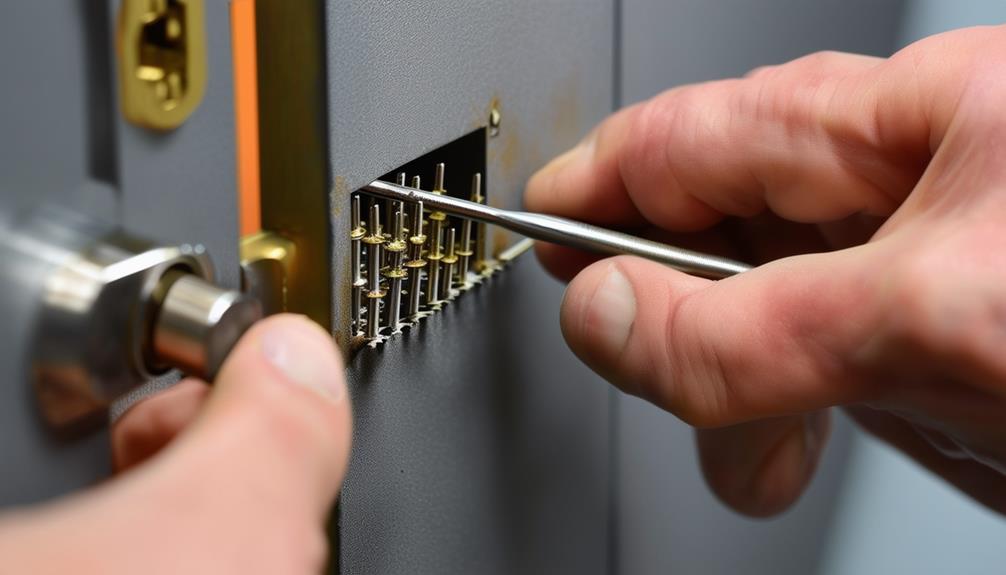
Mastering the art of single-pin picking is essential for security professionals seeking precision in their lock picking techniques. This advanced lock picking technique involves manipulating one pin at a time within the lock cylinder to set each pin to the shear line, allowing the plug to rotate and the lock to open.
Understanding the unique vulnerabilities of different locks, such as pin tumbler locks, can further enhance your effectiveness in this technique, as highlighted in the fundamentals of lock picking. To begin single-pin picking, use a hook-shaped pick to gently lift each pin while applying slight tension to the tension wrench. Start with the first pin and gradually move through each pin until all pins are set correctly.
Single-pin picking requires patience and a delicate touch to feel the feedback from the pins as they set. It's vital to practice this technique to develop a sensitive touch and enhance your understanding of how locks operate.
Bypass Tools and Methods

Now, let's shift our focus to bypass tools and methods.
In addition to traditional techniques, it's crucial to familiarize yourself with non-destructive methods that maintain the integrity of the lock while providing effective access.
You'll get an overview of various bypass techniques and learn about the criteria for selecting the right tools for the job.
This section will equip you with the knowledge needed to effectively bypass locks in the field.
Bypass Techniques Overview
Exploring bypass techniques in lock picking involves delving into a variety of tools and methods that skilled security professionals utilize to navigate security measures.
In the domain of lockpicking techniques, understanding bypass techniques is vital for professionals in the security field.
Here are three key points to take into account when it comes to bypass techniques:
- Impressioning: This technique involves creating a working key for a lock by inserting a blank key and manipulating it to leave markings that represent the lock's pin positions.
- Decoding: Decoding involves using specialized tools to identify the internal mechanism of a lock by feeling the feedback as the pins are manipulated.
- Bumping: Bumping is a technique where a specially designed key, often referred to as a bump key, is used along with a bumping tool to quickly manipulate the pins in a lock and open it.
These bypass techniques are valuable skills for security professionals to possess, allowing them to efficiently navigate various security measures.
Tool Selection Criteria
When selecting bypass tools and methods for lock picking, it's fundamental to contemplate specific criteria that cater to the needs of security professionals. The first consideration is the quality of the tools. Opt for durable, high-quality lock picking tools designed for professionals, as they guarantee precision and longevity.
Additionally, versatility is imperative. Look for tools that can handle various lock types and situations to provide flexibility in your work.
Another essential criterion is ease of use. Select tools that are comfortable to handle and manipulate, allowing you to work efficiently without causing hand fatigue. Portability is also key. Choose compact and lightweight lock picking tools that can be easily transported to different locations.
Moreover, consider the legality of the tools in your jurisdiction. Confirm that the tools you use comply with legal regulations to avoid any potential issues.
Tubular Lock Picking Strategies

With tubular lock picking, precision and technique are essential for successfully bypassing this type of lock. When approaching tubular locks, it's vital to have a good understanding of the strategies that can help you navigate through them effectively.
Regular practice improves your lockpicking skills and enhances your familiarity with the nuances of each lock type, including the importance of purchasing a practice lock to refine your technique.
Here are some key tubular lock picking strategies to keep in mind:
- Use the Right Tool: Make sure you have a high-quality tubular lock pick that fits the specific size and configuration of the lock you're working on.
- Rotate Correctly: Pay close attention to the direction and amount of rotation required to align the pins inside the lock properly.
- Practice Patience: Tubular lock picking can be intricate and time-consuming. Stay focused, patient, and persistent to increase your chances of success.
Impressioning for Non-Destructive Entry

To achieve non-destructive entry in lock picking, one valuable technique to master is impressioning. Impressioning is a method used to create a working key for a lock by making an impression of the keyway and internal components. By inserting a blank key into the lock and manipulating it, you can transfer the necessary markings onto the key. This process allows you to create a key that can successfully operate the lock without causing any damage.
Mastering ethical lock picking is vital for guaranteeing responsible practices in this skill.
Impressioning is a skill that requires patience and attention to detail. It's important to carefully observe the marks left on the key and make precise adjustments to guarantee that the key fits perfectly.
Decoding Locks for Assessment Purposes
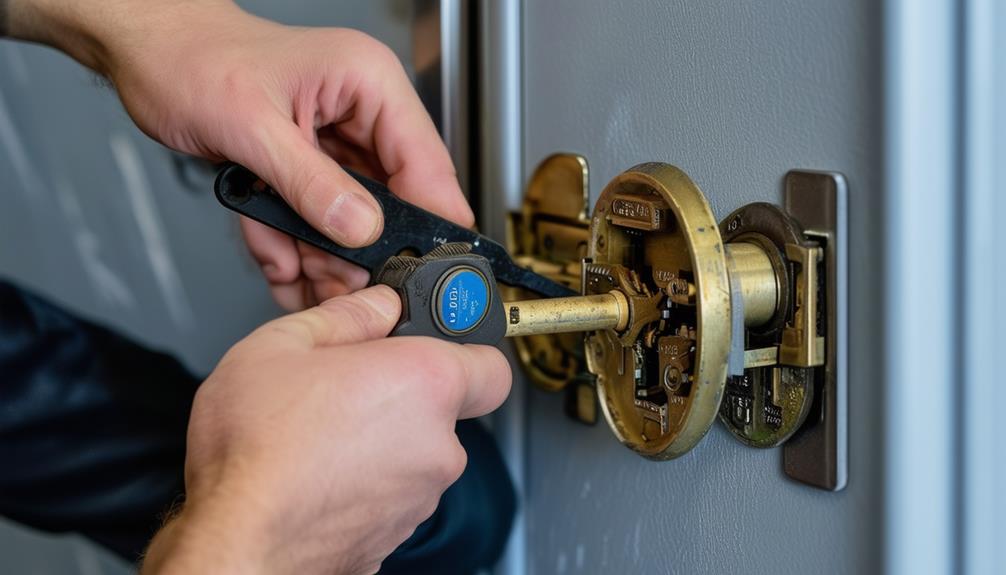
How can security professionals accurately assess the security level of a lock without damaging it?
When it comes to evaluating the effectiveness of locks without causing harm, decoding techniques can be valuable tools for security assessment. By decoding a lock, professionals can gain insights into its vulnerabilities and strengths without the need for destructive methods.
Understanding the mastering pin tumbler lock picking techniques can enhance these decoding efforts, equipping professionals with essential knowledge about common lock types.
Here are three key points to weigh when using decoding for security assessment purposes:
- Understanding Lock Mechanisms: Decoding allows professionals to analyze the inner workings of a lock, providing valuable information on its design and potential weaknesses.
- Identifying Security Flaws: By decoding a lock, security professionals can pinpoint any flaws or vulnerabilities that could be exploited by intruders.
- Assessing Security Measures: Decoding techniques help in evaluating the effectiveness of security measures put in place, highlighting areas that may need improvement.
Advanced Electronic Lock Picking
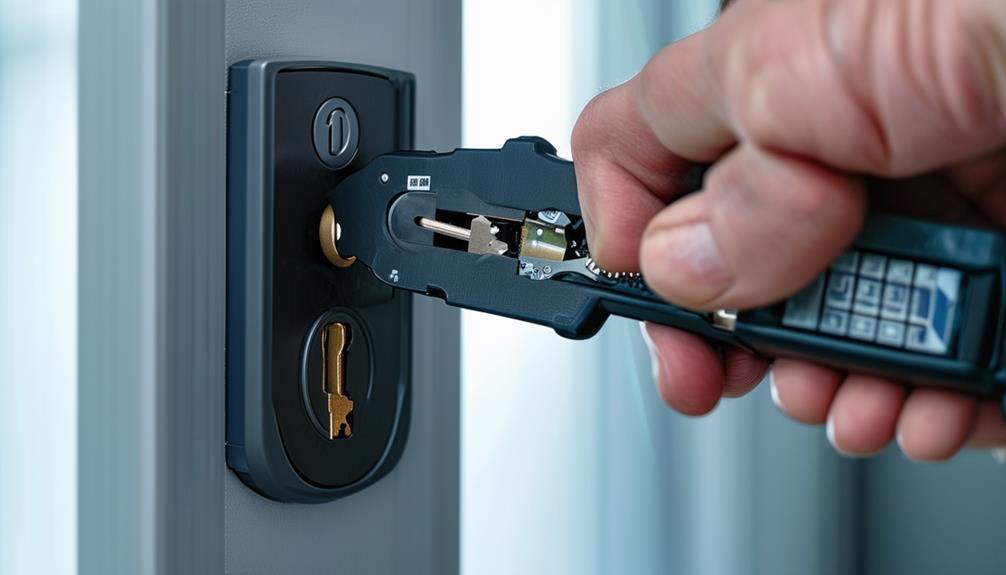
When delving into the domain of advanced electronic lock picking, professionals encounter a new set of challenges and techniques to navigate. Unlike traditional lock picking, advanced electronic lock picking involves bypassing sophisticated security measures that rely on electronic components.
Understanding the various types of electronic locks, such as magnetic locks and biometric locks, is essential for effectively bypassing their security features. To successfully pick an advanced electronic lock, you may need specialized tools such as electronic lock picks, bump keys, or even custom-made devices that can manipulate the electronic components of the lock.
Understanding the inner workings of electronic locks, such as RFID systems or keypad locks, is vital for effectively bypassing their security features. Professionals engaging in advanced electronic lock picking must stay updated on the latest technological advancements in lock security to stay ahead of potential threats.
It requires a combination of skill, knowledge, and precision to master the art of advanced electronic lock picking. Through practice and dedication, security professionals can enhance their abilities to tackle the challenges posed by modern electronic locks.
Practice Tips for Skill Improvement
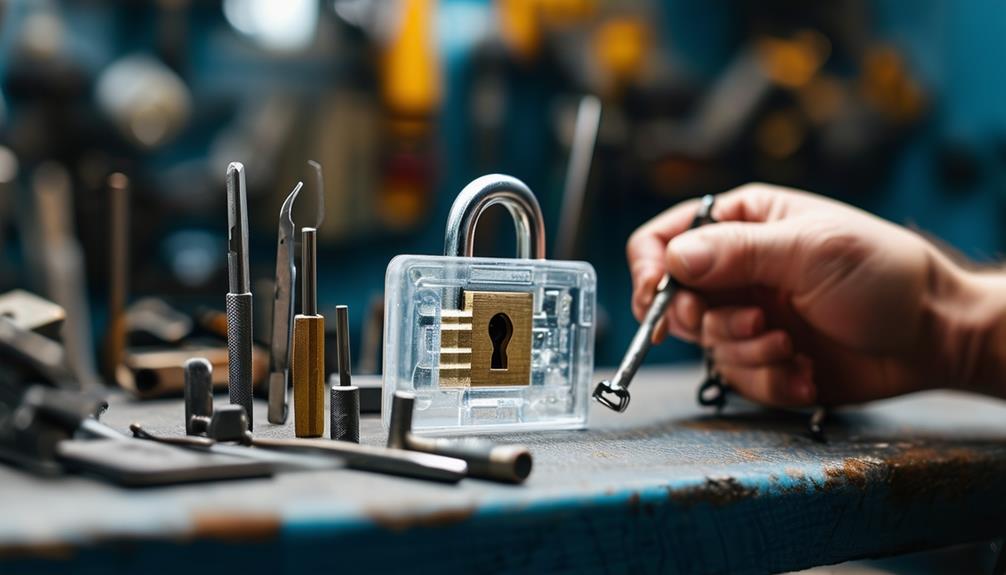
As you hone your skills in advanced electronic lock picking, consistent practice becomes your key ally in achieving mastery. To enhance your proficiency in lock picking for security professionals, consider the following practice tips: Incorporating techniques from strategies and techniques used in competitive environments can also provide a fresh perspective on your skill development.
- Set Specific Goals: Establish clear objectives for each practice session, such as improving speed or mastering a particular technique. Setting goals will help you track your progress and stay motivated.
- Utilize Variety: Practice on a diverse range of locks to expose yourself to different challenges and mechanisms. This variety will broaden your skills and prepare you for a wider array of real-world scenarios.
- Seek Feedback: Don't hesitate to seek feedback from experienced professionals or mentors. Constructive criticism can provide valuable insights and help you identify areas for improvement in your lock picking techniques.
Frequently Asked Questions
Can Lock Picking Damage the Lock Mechanism?
Yes, lock picking can potentially damage the lock mechanism if done incorrectly or forcefully.
When attempting to pick a lock, it's essential to use the right tools and techniques to minimize the risk of harm to the lock.
Applying excessive force or using improper tools can lead to damage, making the lock inoperable and potentially requiring costly repairs or replacements.
It's important to approach lock picking with caution and precision.
How Can I Prevent Being Accused of Illegal Activities?
To avoid being accused of illegal activities, always have a legitimate reason for possessing lock picking tools, like being a locksmith or hobbyist.
Never use your skills for unlawful purposes or without permission. Educate others on the legal aspects of lock picking and emphasize your ethical use of the skill.
Additionally, guarantee you're aware of local laws and regulations surrounding lock picking to stay on the right side of the law.
Are There Legal Restrictions on Owning Lock Picking Tools?
Yes, there are legal restrictions on owning lock picking tools in many places.
It's important to research your local laws to guarantee you're compliant. Possessing these tools without a valid reason or proper authorization can lead to legal trouble.
Stay informed about the regulations in your area to avoid any potential issues.
Can Lock Picking Void a Warranty on a Lock?
Gaining access to a lock through picking may void its warranty, as tampering can alter its integrity.
Manufacturers often stipulate that unauthorized access methods, like lock picking, can nullify any guarantees.
It's essential to check the warranty terms before attempting any non-standard entry techniques.
Remember, messing with the lock in unauthorized ways could mean you're on your own for any issues that arise.
Always prioritize following the manufacturer's guidelines to avoid any potential warranty problems.
What Should I Do if I Accidentally Lock Myself Out?
If you accidentally lock yourself out, first try to stay calm.
Check for any open windows or doors you might've forgotten about.
If that doesn't work, see if a neighbor or friend has a spare key.
If all else fails, consider calling a professional locksmith to help you regain entry.
It's important to prioritize your safety and seek assistance as needed to prevent any damage to your property.
Conclusion
Now that you've mastered the basics of lock picking techniques and tools, it's time to take your skills to the next level. With advanced electronic lock picking and practice tips for improvement, the possibilities are endless. Stay tuned for more in-depth guides and expert tips to enhance your security professional toolkit. Keep practicing, keep learning, and keep pushing the boundaries of what you thought was possible. The world of lock picking is at your fingertips.

